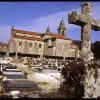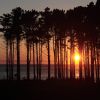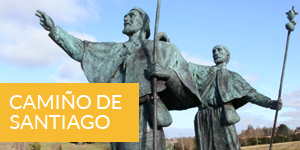- Accede I
- Regístrate I
- carrito
Padrón: el origen de la leyenda jacobea
Duración: 1/2 día
Itinerario: Padrón - Iria Flavia - A Escravitude - Bastavales
Descripción: Padrón es el primer lugar que aparece en la leyenda jacobea. En el casco histórico de Padrón merecen ser visitados, además de las rúas, el “Pedrón” del que habla la leyenda, en el que amarró la barca del Apóstol, el Convento del Carmen, con mirador sobre la villa, y la casa de la poetisa romántica Rosalía de Castro. La ruta está marcada por dos ríos, el Sar y el Ulla, y por sus amables y productivas vegas, en las que nacen los archiconocidos Pimientos de Padrón.
Paradas recomendadas
Padrón-Iria Flavia-A Escravitude-Bastavales
Padrón es el lugar donde supuestamente todo empezó, el primer topónimo que aparece en la leyenda más importante de Galicia: la leyenda jacobea. Y de ello queda constancia en los santuarios, en los nombres de los lugares y en la atmósfera de esta tierra.
La ruta está marcada por dos ríos, el Sar y el Ulla, en cuya confluencia se sitúa la población padronesa, y por sus amables y productivas vegas, en las que nacen los exquisitos y reconocidos pimientos de Padrón.
Padrón
La villa de Padrón, a 20 kilómetros de la ciudad, estuvo desde siempre muy vinculada a Compostela. Parece que su nombre puede proceder de 'pedrón', piedra en la que supuestamente amarraron la barca que trasladó el cuerpo del Apóstol Santiago desde Palestina hasta las costas gallegas. El Sar, el río de Compostela, es también el de Padrón, que quedan así vinculados por este brazo de agua. Por su proximidad a la desembocadura del Ulla, Padrón fue, en el Medievo, parada obligada en la salida de los compostelanos hacia el mar y dársena de entrada de los peregrinos que llegaban del océano. Por su situación entre Santiago, Pontevedra y la ría de Arousa, Padrón es, desde la época romana, un punto neurálgico de los viales gallegos.
Visita obligada es la Casa Museo de Rosalía de Castro, en las afueras de Padrón, enfrente de la estación de tren padronesa, conocida también como Casa da Matanza, que es el nombre del lugar. En ella pasó los últimos años de su vida la escritora Rosalía de Castro, figura principal de las letras gallegas. Además del recuerdo de la autora, la casa nos brinda la oportunidad de conocer los espacios interiores de la arquitectura tradicional de la zona.
A sólo un par de kilómetros de la Casa de Rosalía está el Convento Franciscano de Herbón. El cenobio se asienta al lado de una frondosa robleda y del río Ulla, famoso por sus lampreas, truchas y salmones. De Herbón salieron los primeros pimientos de Padrón, que parece ser que fueron traídos de México por los monjes franciscanos en el siglo XVI. Estos pequeños pimientos verdes son uno de los productos más conocidos de la gastronomía gallega y, según advierte el dicho 'los pimientos de Padrón, unos pican y otros no'.
Próximo a la casa de la escritora está el pequeño jardín botánico-artístico, orgullo de los padroneses.
Padrón, burgo de origen medieval, conserva todavía el encanto del pasado en sus rincones: el Pazo del Obispo de Quito, la plaza de Macías O Namorado (El Enamorado), legendario trovador de esta tierra que murió a manos del marido furioso cuando cantaba el dolor de su amor imposible.
El pedrón del que habla la leyenda jacobea se encuentra debajo del altar de la iglesia parroquial de Santiago, mandada construír por Xelmírez, el arzobispo de Compostela, en la margen del río. Justo enfrente, el Espolón, paseo arbolado a la orilla del Sar que cada domingo es ocupado por una concurridaísima feria, que se enorgullece de ofrecer, entre otras mercancías, las mejores frutas y verduras de la huerta padronesa.
Cruzando por el puente de Santiago, se llega a la fuente de O Carme. En su arco, grabada en la piedra, la barca donde los discípulos trasladaron el cuerpo del Apóstol. Siguiendo la enlosada cuesta se llega al Convento do Carme, erigido sobre la roca granítica de la ladera del monte de San Gregorio. La iglesia, única zona accesible a los ojos, es distinguida y hermosa. Desde el atrio, una visión planimétrica de Padrón y sus alrededores.
Iria Flavia, A Escravitude y Bastavales
Iria Flavia es un topónimo de fuerte evocación pero de difícil explicación. Este lugar, que sale a la carretera poco después de salir de Padrón, fue la sede episcopal hasta su traslado a Santiago en el siglo XI. Hoy es Iglesia parroquial de Santa María de Adina. Las torres piramidales y la portada románico-ojival dan cuenta de su esplendor pasado.
En el entorno de la iglesia yacen al aire libre interesantes sepulcros antropomorfos de época sueva. El campo santo de Iria, al lado de la iglesia, fue fielmente retratado en las nostálgicas palabras de la poetisa Rosalía de Castro: El cementerio de Adina / no hay duda que es encantador, / con sus olivos oscuros / de viejo recuerdo, / con su suelo de hierbas y flores, / lindas como ningunas otras dio Dios. En él yacen los restos de otro gran literato: el premio Nobel Camilo José Cela, oriundo de Iria Flavia.
Frente al templo parroquial, una interesante composición de edificios del S. XVIII, conocida como Casa de los Canónigos, acoge el pequeño Museo de Arte Sacro de Iria Flavia, el museo del ferrocarril John Trulock y la Fundación Camilo José Cela, con objetos y recuerdos personales del escritor. En el jardín lateral reposan para siempre las locomotoras Sarita y Sestao, pioneras en recorrer el trazado férreo gallego.
El Santuario de A Escravitude, que señala el límite de las tierras de Padrón, se asoma a la carretera casi como si de una torre vigía se tratase. Cuenta la leyenda que un hombre que iba camino de Compostela sanó súbitamente de su enfermedad después de beber agua de esta fuente. Agradecido, alababa a la Virgen por haberle liberado de la esclavitud de su mal, lo que explica el origen del nombre del lugar. Este hermoso y espigado edificio, que fusiona barroco y neoclásico, fue levantado para custodia de la fuente milagrosa que se encuentra a sus pies.
En el lado derecho del templo nace una poco común aldea de casitas alineadas y casi homogéneas encaramadas a una única calle que conduce hasta un otero desde el que se avista la vega del río Sar. Por la izquierda del templo, sale un camino que llega hasta la pequeña y solitaria iglesia parroquial, de ábside románico. Desde esta elevada plataforma, otra panorámica de la zona.
El valle de Bastavales, verde, suave y prolífico, está presidido por la esbelta torre barroca de la Iglesia de San Xulián, que inmortalizó, al igual que todas estas tierras, la romántica Rosalía de Castro: Campanas de Bastavales / cuando os oigo tocar / me muero de soledad...





















